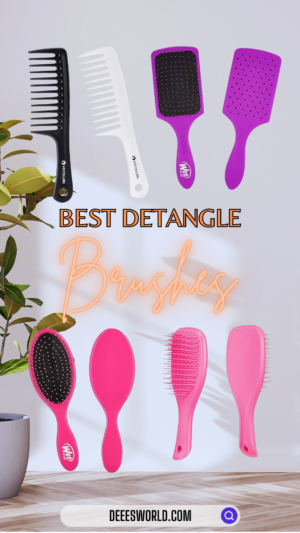Detangling brushes are lifesavers when it comes to managing knots and tangles in your hair. However, with so many options available, it can be challenging to choose the right one for your hair type. In this guide, we'll explore the pros and cons of different types of detangling brushes to help you make an informed decision.

1. Wide-Tooth Comb

A wide-tooth comb is great for detangling curly, voluminous, or textured hair. It glides smoothly through your hair without causing frizz or breakage. It also helps distribute hair products evenly from root to tip. It's an essential tool that can keep your hair healthy and tangle-free
Best For:
- Thick, curly, or coarse hair textures.
- Detangling after washing or conditioning.
How to Use:
- Start by applying a leave-in conditioner or detangling spray to damp hair.
- Divide your hair into sections for easier detangling.
- Begin combing from the ends, working your way up to the roots.
- Use gentle, steady strokes to work through knots and tangles without causing breakage.
Pros:
- Ideal for distributing conditioner evenly.
- Gentle on the scalp when handled carefully.
- Helps prevent breakage in textured hair.
Cons:
- Less effective for fine or straight hair.
- Requires patience and careful handling to avoid damage.
2. Paddle Brush

The paddle brush helps achieve smooth and shiny hair. It untangles knots, distributes natural oils, and suits all hair types. Its flexible bristles minimize breakage and promote healthy-looking hair.
Best For:
- Straight or wavy hair types.
- Detangling dry or slightly damp hair.
- Smoothing and styling while detangling.
How to Use:
- Start brushing from the ends and gradually move towards the roots.
- Use short strokes to work through knots and tangles.
- Can be used with heat styling tools for smooth, straight styles.
Pros:
- Great for daily detangling and styling.
- Helps distribute natural oils from the scalp to the ends.
- Suitable for use with heat styling tools.
Cons:
- Not as effective for very thick or tightly coiled hair.
- May not tackle severe knots or tangles easily.
3. Detangling Brush with Flexible Bristles

This hairbrush has flexible bristles that adjust to knots and tangles, making detangling easy without causing damage. It also promotes hair growth by providing a gentle massage. It works on all hair types, wet or dry, distributes natural oils, and is gentle on your hair and scalp. It's perfect for daily hair care and styling, lightweight, durable, and easy to use.
Best For:
- All hair types, including fine, medium, and thick hair.
- Wet or dry detangling without causing breakage.
How to Use:
- Apply a detangling spray or leave-in conditioner for added slip.
- Use gentle, sweeping motions from ends to roots.
- The flexible bristles bend to accommodate knots without pulling or tugging.
Pros:
- Minimizes hair breakage during detangling.
- Suitable for use on both wet and dry hair.
- Versatile for various hair textures.
Cons:
- Some models may struggle with very thick or tightly coiled hair.
- Requires occasional cleaning to maintain effectiveness.
4. Tangle Teezer or Similar Compact Brushes

These brushes detangle hair easily and quickly. They're compact and portable, perfect for people on-the-go. Made of high-quality materials with gentle bristles that prevent breakage. Great for maintaining hair's health and appearance anywhere. Effective, durable, and portable, a worthwhile investment.
Best For:
- All hair types, including fine hair and children's hair.
- On-the-go detangling and touch-ups.
How to Use:
- Use short, gentle strokes to work through knots.
- Can be used on dry or slightly damp hair.
- The compact size makes it travel-friendly.
Pros:
- Gentle on the scalp and hair.
- Perfect for carrying in your purse or travel bag.
- Suitable for quick touch-ups throughout the day.
Cons:
- May not handle very thick or severely tangled hair.
- Some users may find the design less comfortable for extended use.

General Tips for Using Detangling Brushes:
- Always start from the end and work your way up to prevent breakage.
- Apply a detangling product for added slip and ease of brushing.
- Divide your hair into sections for easier detangling, especially for thick or tangled hair.
- Be gentle and avoid yanking or pulling on knots to prevent damage.
- Make detangling a regular part of your hair care routine to maintain healthy, tangle-free hair.
In conclusion, choosing the right detangling brush depends on your hair type, texture, and specific needs. Consider the detailed information provided for each type to make an informed decision, and master the art of detangling for beautiful, manageable hair every day.
